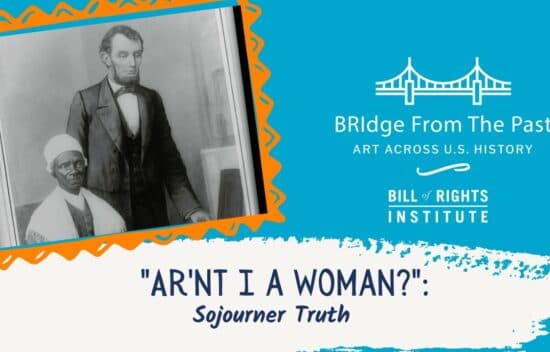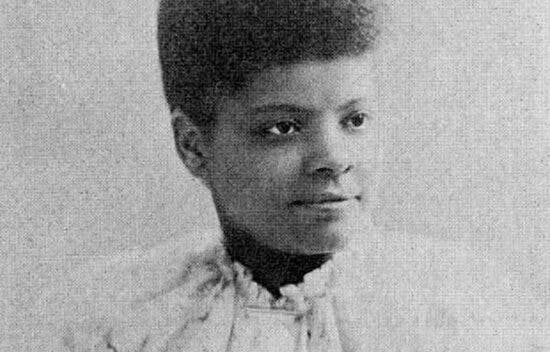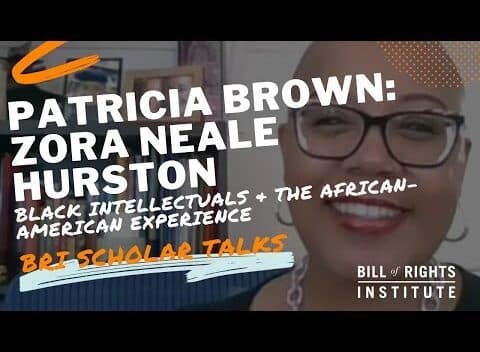



Black Women in American History
17 items

Elizabeth (Mumbet) Freeman portrait, 1811 and Legal notes by Chief Justice William Cushing about the Quock Walker case, 1783
Activity
Activity

Anna Julia Cooper with Anika Prather | Black Intellectuals Series #5
Video
Video
26 Min
What contribution did Anna Julia Cooper, prominent African-American author and educator, make to understanding the Black experience in America? In this episode of our Scholar Talk series "Black Intellectuals and the African American Experience," BRI Senior Teaching Fellow Tony Williams is joined by Anika Prather, Professor of English at Howard University, to discuss the unique ways Cooper advocated for equal educational and economic opportunities of Black Americans. As a high school teacher and college professor at Black institutions, how did Cooper use Founding principles of equality and dignity to empower others?
26 Min

“Ar’nt I a Woman?” Sojourner Truth and the Abolitionist Movement | BRIdge from the Past
Video
Video
10 Min
How can images help us understand the role of African American women in the abolitionist movement? In this episode, Mary explores an image of Sojourner Truth. Born into slavery in New York, she dedicated her life to abolition and equal rights for women and men. How did her famous "Ar'nt I a Woman?" speech convey her life-long commitment to the ideals of liberty and equality?
*The source we reviewed used the phrase "Ar'nt I a Woman?" but Sojourner Truth's speech is often also titled "Ain't I a Woman?"
10 Min

Taking Responsibility: Ida B. Wells and the Anti-Lynching Campaign
Lesson - 1 Activities
Lesson
1 Activities
45 Min
How did Ida B. Wells’ anti-lynching campaign and her teaching of others about lynching show responsibility?
45 Min

Zora Neale Hurston with Patricia Brown | Black Intellectuals Series #4
Video
Video
22 Min
How did Zora Neale Hurston, noted African-American writer during the Harlem Renaissance, contribute to understanding the Black experience in America? In this episode of our Scholar Talk series "Black Intellectuals and the African American Experience," BRI Senior Teaching Fellow Tony Williams is joined by Patricia Brown, professor of English at Azusa Pacific University, to discuss Hurston's unique examination and celebration of Black expression, creativity, and resiliency. How did Hurston's book "Their Eyes Were Watching God" convey a message of Black women's freedom and self-discovery?
22 Min

Marian Anderson at the Lincoln Memorial: Eleanor Roosevelt, Harold Ickes, & Racial Discrimination
Video
Video
8 Min
What does the Lincoln Memorial mean to us today? In this episode of BRIdge from the Past, Mary examines pictures of Marian Anderson’s 1939 concert at the Lincoln Memorial. After being denied a performance in Constitution Hall due to racial discrimination, Anderson was invited with the help of several individuals to deliver the biggest concert of her career in front of 75,000 people on Easter Sunday, 1939. How did Harold Ickes and Eleanor Roosevelt’s actions showcase a call for racial equality throughout the United States in 1939? What legacy did Anderson’s legendary performance have on the Lincoln Memorial?
8 Min

Fannie Lou Hamer Testimony before the Credentials Committee, Democratic National Convention, August 22, 1964
Activity
Activity

Barbara Jordan, Watergate, and Justice
Lesson - 1 Activities
Lesson
1 Activities
45 Min
In this lesson, students will learn how Barbara Jordan sought justice during the Watergate scandal. They will also learn how they can protect justice in their lives.
45 Min

On My Own Ground: Madam C.J. Walker and Identity
Lesson - 1 Activities
Lesson
1 Activities
45 Min
How did Madam C. J. Walker contribution to American identity?
45 Min

Rosa Parks, the Montgomery Bus Boycott, and Purpose
Lesson - 1 Activities
Lesson
1 Activities
45 Min
What about Rosa Parks’ purpose lead her to participate in the Montgomery Bus Boycott?
45 Min

Rosa Parks’s Account of the Montgomery Bus Boycott (Radio Interview), April 1956
Activity
Activity
40 Min
Use this primary source text to explore key historical events.

Harriet Tubman: Follow the North Star to Freedom
Lesson - 1 Activities
Lesson
1 Activities
45 Min
How did Harriet Tubman act responsibly by helping many people escape slavery?
45 Min

How Did Landscape Affect Harriet Tubman? The Outdoors, Slavery, & the Underground Railroad
Video
Video
14 Min
Harriet Tubman, the most famous conductor of the Underground Railroad, grew up on the Eastern Shore of Maryland before escaping to freedom in 1849. She returned to the Eastern Shore 13 times to free family and friends from bondage. How can looking at the landscape of the Eastern Shore help us understand Tubman's amazing story and the Underground Railroad itself? Mary is joined by Timothy VanCleave, Park Ranger at the Harriet Tubman Underground Railroad National Historic Park in Maryland, to explore.
14 Min



